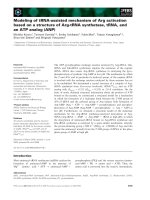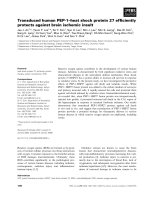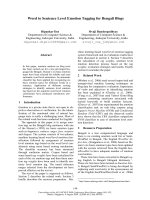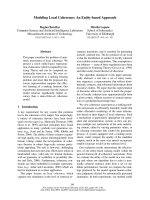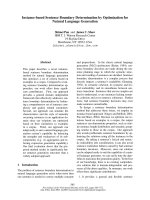Báo cáo khoa học: "Modeling Human Sentence Processing Data with a Statistical Parts-of-Speech Tagger" ppt
Bạn đang xem bản rút gọn của tài liệu. Xem và tải ngay bản đầy đủ của tài liệu tại đây (108.97 KB, 6 trang )
Proceedings of the COLING/ACL 2006 Student Research Workshop, pages 25–30,
Sydney, July 2006.
c
2006 Association for Computational Linguistics
Modeling Human Sentence Processing Data with a Statistical
Parts-of-Speech Tagger
Jihyun Park
Department of Linguisitcs
The Ohio State University
Columbus, OH, USA
Abstract
It has previously been assumed in the
psycholinguistic literature that finite-state
models of language are crucially limited
in their explanatory power by the local-
ity of the probability distribution and the
narrow scope of information used by the
model. We show that a simple computa-
tional model (a bigram part-of-speech tag-
ger based on the design used by Corley
and Crocker (2000)) makes correct predic-
tions on processing difficulty observed in a
wide range of empirical sentence process-
ing data. We use two modes of evaluation:
one that relies on comparison with a con-
trol sentence, paralleling practice in hu-
man studies; another that measures prob-
ability drop in the disambiguating region
of the sentence. Both are surprisingly
good indicators of the processing difficulty
of garden-path sentences. The sentences
tested are drawn from published sources
and systematically explore five different
types of ambiguity: previous studies have
been narrower in scope and smaller in
scale. We do not deny the limitations of
finite-state models, but argue that our re-
sults show that their usefulness has been
underestimated.
1 Introduction
The main purpose of the current study is to inves-
tigate the extent to which a probabilistic part-of-
speech (POS) tagger can correctly model human
sentence processing data. Syntactically ambigu-
ous sentences have been studied in great depth in
psycholinguistics because the pattern of ambigu-
ity resolution provides a window onto the human
sentence processing mechanism (HSPM). Prima
facie it seems unlikely that such a tagger will be
adequate, because almost all previous researchers
have assumed, following standard linguistic the-
ory, that a formally adequate account of recur-
sive syntactic structure is an essential component
of any model of the behaviour. In this study, we
tested a bigram POS tagger on different types of
structural ambiguities and (as a sanity check) to
the well-known asymmetry of subject and object
relative clause processing.
Theoretically, the garden-path effect is defined
as processing difficulty caused by reanalysis. Em-
pirically, it is attested as comparatively slower
reading time or longer eye fixation at a disam-
biguating region in an ambiguous sentence com-
pared to its control sentences (Frazier and Rayner,
1982; Trueswell, 1996). That is, the garden-path
effect detected in many human studies, in fact, is
measured through a “comparative” method.
This characteristic of the sentence processing
research design is reconstructed in the current
study using a probabilistic POS tagging system.
Under the assumption that larger probability de-
crease indicates slower reading time, the test re-
sults suggest that the probabilistic POS tagging
system can predict reading time penalties at the
disambiguating region of garden-path sentences
compared to that of non-garden-path sentences
(i.e. control sentences).
2 Experiments
A Hidden Markov Model POS tagger based on bi-
grams was used. We made our own implementa-
tion to be sure of getting as close as possible to
the design of Corley and Crocker (2000). Given
a word string, w
0
, w
1
, · · · , w
n
, the tagger calcu-
lates the probability of every possible tag path,
25
t
0
, · · · , t
n
. Under the Markov assumption, the
joint probability of the given word sequence and
each possible POS sequence can be approximated
as a product of conditional probability and transi-
tion probability as shown in (1).
(1) P(w
0
, w
1
, · · · , w
n
, t
0
, t
1
, · · · , t
n
)
≈ Π
n
i=1
P (w
i
|t
i
) · P (t
i
|t
i−1
), where n ≥ 1.
Using the Viterbi algorithm (Viterbi, 1967), the
tagger finds the most likely POS sequence for a
given word string as shown in (2).
(2) arg max P (t
0
, t
1
, · · · , t
n
|w
0
, w
1
, · · · , w
n
, µ).
This is known technology, see Manning and
Sch
¨
utze (1999), but the particular use we make
of it is unusual. The tagger takes a word string
as an input, outputs the most likely POS sequence
and the final probability. Additionally, it presents
accumulated probability at each word break and
probability re-ranking, if any. Probability re-
ranking occurs when a previously less preferred
POS sequence is more favored later. Note that the
running probability at the beginning of a sentence
will be 1, and will keep decreasing at each word
break since it is a product of conditional probabil-
ities.
We tested the predictability of the model on
empirical reading data with the probability de-
crease and the presence or absence of probabil-
ity re-ranking. Probability re-ranking occurs when
a less preferred POS sequence is selected later
over a temporarily favored sequence. Adopting
the standard experimental design used in human
sentence processing studies, where word-by-word
reading time or eye-fixation time is compared be-
tween an experimental sentence and its control
sentence, this study compares probability at each
word break between a pair of sentences. Compar-
atively faster drop of probability is expected to be
a good indicator of comparative processing diffi-
culty. Probability re-ranking, which is a simpli-
fied model of the reanalysis process assumed in
many human studies, is also tested as another indi-
cator of garden-path effect. Probability re-ranking
will occur when an initially dispreferred POS sub-
sequence becomes the preferred candidate later in
the parse, because it fits in better with later words.
The model parameters, P (w
i
|t
i
) and
P (t
i
|t
i−1
), are estimated from a small sec-
tion (970,995 tokens,47,831 distinct words) of
the British National Corpus (BNC), which is a
100 million-word collection of British English,
both written and spoken, developed by Oxford
University Press (Burnard, 1995). The BNC was
chosen for training the model because it is a
POS-annotated corpus, which allows supervised
training. In the implementation we use log
probabilities to avoid underflow, and we report
log probabilities in the sequel.
2.1 Hypotheses
If the HSPM is affected by frequency information,
we can assume that it will be easier to process
events with higher frequency or probability com-
pared to those with lower frequency or probability.
Under this general assumption, the overall diffi-
culty of a sentence is expected to be measured or
predicted by the mean size of probability decrease.
That is, probability will drop faster in garden-path
sentences than in control sentences (e.g. unam-
biguous sentences or ambiguous but non-garden-
path sentences).
More importantly, the probability decrease pat-
tern at disambiguating regions will predict the
trends in the reading time data. All other things be-
ing equal, we might expect a reading time penalty
for a garden-path region when the size of the prob-
ability decrease at the disambiguating region of a
garden-path sentence will be greater than that of
control sentences. This is a simple and intuitive
assumption that can be easily tested. We could
have formed the sum over all possible POS se-
quences in association with the word strings, but
for the present study we simply used the Viterbi
path: justifying this because this is the best single-
path approximation to the joint probability.
Lastly, re-ranking of POS sequences is expected
to predict reanalysis of lexical categories. This is
because re-ranking in the tagger is parallel to re-
analysis in human subjects, which is known to be
cognitively costly.
2.2 Materials
In this study, five different types of ambigu-
ity were tested including Lexical Category am-
biguity, Reduced-relative ambiguity (RR am-
biguity), Preposition-phrase attachment ambi-
guity (PP ambiguity), Direct-object/Sentential-
complement ambiguity (DO/SC ambiguity), and
Clausal Boundary ambiguity. The following are
example sentences for each ambiguity type, shown
with the ambiguous region italicized and the dis-
26
ambiguating region bolded. All of the example
sentences are garden-path sentneces.
(3) Lexical Category ambiguity
The foreman knows that the warehouse
prices the beer very modestly.
(4) RR ambiguity
The horse raced past the barn fell.
(5) PP ambiguity
Katie laid the dress on the floor onto the bed.
(6) DO/SC ambiguity
He forgot Pam needed a ride with him.
(7) Clausal Boundary ambiguity
Though George kept on reading the story re-
ally bothered him.
The test materials are constructed such that
a garden-path sentence and its control sentence
share exactly the same word sequence except for
the disambiguating word so that extraneous vari-
ables such as word frequency effect can be con-
trolled. We inherit this careful design.
In this study, a total of 76 sentences were
tested: 10 for lexical category ambiguity, 12 for
RR ambiguity, 20 for PP attachment ambigu-
ity, 16 for DO/SC ambiguity, and 18 for clausal
boundary ambiguity. This set of materials is, to
our knowledge, the most comprehensive yet sub-
jected to this type of study. The sentences are di-
rectly adopted from various psycholinguistic stud-
ies (Frazier, 1978; Trueswell, 1996; Ferreira and
Henderson, 1986).
As a baseline test case of the tagger, the
well-established asymmetry between subject- and
object-relative clauses was tested as shown in (8).
(8) a. The editor who kicked the writer fired the
entire staff. (Subject-relative)
b. The editor who the writer kicked fired the
entire staff. (Object-relative)
The reading time advantage of subject-relative
clauses over object-relative clauses is robust in En-
glish (Traxler et al., 2002) as well as other lan-
guages (Mak et al., 2002; Homes et al., 1981). For
this test, materials from Traxler et al. (2002) (96
sentences) are used.
3 Results
3.1 The Probability Decrease per Word
Unambiguous sentences are usually longer than
garden-path sentences. To compare sentences of
different lengths, the joint probability of the whole
sentence and tags was divided by the number of
words in the sentence. The result showed that
the average probability decrease was greater in
garden-path sentences compared to their unam-
biguous control sentences. This indicates that
garden-path sentences are more difficult than un-
ambiguous sentences, which is consistent with
empirical findings.
Probability decreased faster in object-relative
sentences than in subject relatives as predicted.
In the psycholinguistics literature, the comparative
difficulty of object-relative clauses has been ex-
plained in terms of verbal working memory (King
and Just, 1991), distance between the gap and the
filler (Bever and McElree, 1988), or perspective
shifting (MacWhinney, 1982). However, the test
results in this study provide a simpler account for
the effect. That is, the comparative difficulty of
an object-relative clause might be attributed to its
less frequent POS sequence. This account is par-
ticularly convincing since each pair of sentences in
the experiment share the exactly same set of words
except their order.
3.2 Probability Decrease at the
Disambiguating Region
A total of 30 pairs of a garden-path sentence
and its ambiguous, non-garden-path control were
tested for a comparison of the probability decrease
at the disambiguating region. In 80% of the cases,
the probability drops more sharply in garden-path
sentences than in control sentences at the critical
word. The test results are presented in (9) with
the number of test sets for each ambiguous type
and the number of cases where the model correctly
predicted reading-time penalty of garden-path sen-
tences.
(9) Ambiguity Type (Correct Predictions/Test
Sets)
a. Lexical Category Ambiguity (4/4)
b. PP Attachment Ambiguity (10/10)
c. RR Ambiguity (3/4)
d. DO/SC Ambiguity (4/6)
e. Clausal Boundary Ambiguity (3/6)
27
−60
−55
−50
−45
−40
−35
Log Probability
(a) PP Attachment Ambiguity
Katie put the dress on the floor and / onto the
−35
−30
−25
−20
−15
Log Probability
(b) DO / SC Ambiguity (DO Bias)
He forgot Susan but / remembered
the
and
the
floor
the
onto
Susan
but
remembered
forgot
Figure 1: Probability Transition (Garden-Path vs.
Non Garden-Path)
(a) − ◦ − : Non-Garden-Path (Adjunct PP), − ∗ − : Garden-
Path (Complement PP)
(b) − ◦ − : Non-Garden-Path (DO-Biased, DO-Resolved),
− ∗ − : Garden-Path (DO-Biased, SC-Resolved)
The two graphs in Figure 1 illustrate the com-
parison of probability decrease between a pair of
sentence. The y-axis of both graphs in Figure 1 is
log probability. The first graph compares the prob-
ability drop for PP ambiguity (Katie put the dress
on the floor and/onto the bed ) The empirical re-
sult for this type of ambiguity shows that reading
time penalty is observed when the second PP, onto
the bed, is introduced, and there is no such effect
for the other sentence. Indeed, the sharper proba-
bility drop indicates that the additional PP is less
likely, which makes a prediction of a comparative
processing difficulty. The second graph exhibits
the probability comparison for the DO/SC ambi-
guity. The verb forget is a DO-biased verb and
thus processing difficulty is observed when it has
a sentential complement. Again, this effect was
replicated here.
The results showed that the disambiguating
word given the previous context is more difficult
in garden-path sentences compared to control sen-
tences. There are two possible explanations for
the processing difficulty. One is that the POS se-
quence of a garden-path sentence is less probable
than that of its control sentence. The other account
is that the disambiguating word in a garden-path
sentence is a lower frequency word compared to
that of its control sentence.
For example, slower reading time was observed
in (10a) and (11a) compared to (10b) and (11b) at
the disambiguating region that is bolded.
(10) Different POS at the Disambiguating Region
a. Katie laid the dress on the floor onto
(−57.80) the bed.
b. Katie laid the dress on the floor after
(−55.77) her mother yelled at her.
(11) Same POS at the Disambiguating Region
a. The umpire helped the child on (−42.77)
third base.
b. The umpire helped the child to (−42.23)
third base.
The log probability for each disambiguating word
is given at the end of each sentence. As ex-
pected, the probability at the disambiguating re-
gion in (10a) and (11a) is lower than in (10b) and
(11b) respectively. The disambiguating words in
(10) have different POS’s; Preposition in (10a) and
Conjunction (10b). This suggests that the prob-
abilities of different POS sequences can account
for different reading time at the region. In (11),
however, both disambiguating words are the same
POS (i.e. Preposition) and the POS sequences
for both sentences are identical. Instead, “on”
and “to”, have different frequencies and this in-
formation is reflected in the conditional probabil-
ity P (word
i
|state). Therefore, the slower read-
ing time in (11b) might be attributable to the lower
frequency of the disambiguating word, “to” com-
pared to “on”.
3.3 Probability Re-ranking
The probability re-ranking reported in Corley and
Crocker (2000) was replicated. The tagger suc-
cessfully resolved the ambiguity by reanalysis
when the ambiguous word was immediately fol-
lowed by the disambiguating word (e.g. With-
out her he was lost.). If the disambiguating word
did not immediately follow the ambiguous region,
(e.g. Without her contributions would be very in-
adequate.) the ambiguity is sometimes incorrectly
resolved.
When revision occurred, probability dropped
more sharply at the revision point and at the dis-
ambiguation region compared to the control sen-
28
tences. When the ambiguity was not correctly re-
solved, the probability comparison correctly mod-
eled the comparative difficulty of the garden-path
sentences
Of particular interest in this study is RR ambi-
guity resolution. The tagger predicted the process-
ing difficulty of the RR ambiguity with probabil-
ity re-ranking. That is, the tagger initially favors
the main-verb interpretation for the ambiguous -ed
form, and later it makes a repair when the ambigu-
ity is resolved as a past-participle.
The RR ambiguity is often categorized as a syn-
tactic ambiguity, but the results suggest that the
ambiguity can be resolved locally and its pro-
cessing difficulty can be detected by a finite state
model. This suggests that we should be cautious
in assuming that a structural explanation is needed
for the RR ambiguity resolution, and it could be
that similar cautions are in order for other ambi-
guities usually seen as syntactic.
4 Discussion
The current study explores Corley and Crocker’s
model(2000) further on the model’s account of hu-
man sentence processing data seen in empirical
studies. Although there have been studies on a
POS tagger evaluating it as a potential cognitive
module of lexical category disambiguation, there
has been little work that tests it as a modeling tool
of syntactically ambiguous sentence processing.
The findings here suggest that a statistical POS
tagging system is more informative than Crocker
and Corley demonstrated. It has a predictive
power of processing delay not only for lexi-
cally ambiguous sentences but also for structurally
garden-pathed sentences. This model is attractive
since it is computationally simpler and requires
few statistical parameters. More importantly, it is
clearly defined what predictions can be and can-
not be made by this model. This allows system-
atic testability and refutability of the model un-
like some other probabilistic frameworks. Also,
the model training and testing is transparent and
observable, and true probability rather than trans-
formed weights are used, all of which makes it
easy to understand the mechanism of the proposed
model.
Although the model we used in the current
study is not a novelty, the current work largely dif-
fers from the previous study in its scope of data
used and the interpretation of the model for human
sentence processing. Corley and Crocker clearly
state that their model is strictly limited to lexical
ambiguity resolution, and their test of the model
was bounded to the noun-verb ambiguity. How-
ever, the findings in the current study play out dif-
ferently. The experiments conducted in this study
are parallel to empirical studies with regard to the
design of experimental method and the test mate-
rial. The garden-path sentences used in this study
are authentic, most of them are selected from the
cited literature, not conveniently coined by the
authors. The word-by-word probability compar-
ison between garden-path sentences and their con-
trols is parallel to the experimental design widely
adopted in empirical studies in the form of region-
by-region reading or eye-gaze time comparison.
In the word-by-word probability comparison, the
model is tested whether or not it correctly pre-
dicts the comparative processing difficulty at the
garden-path region. Contrary to the major claim
made in previous empirical studies, which is that
the garden-path phenomena are either modeled by
syntactic principles or by structural frequency, the
findings here show that the same phenomena can
be predicted without such structural information.
Therefore, the work is neither a mere extended
application of Corley and Crocker’s work to a
broader range of data, nor does it simply con-
firm earlier observations that finite state machines
might accurately account for psycholinguistic re-
sults to some degree. The current study provides
more concrete answers to what finite state machine
is relevant to what kinds of processing difficulty
and to what extent.
5 Conclusion
Our studies show that, at least for the sample of
test materials that we culled from the standard lit-
erature, a statistical POS tagging system can pre-
dict processing difficulty in structurally ambigu-
ous garden-path sentences. The statistical POS
tagger was surprisingly effective in modeling sen-
tence processing data, given the locality of the
probability distribution. The findings in this study
provide an alternative account for the garden-path
effect observed in empirical studies, specifically,
that the slower processing times associated with
garden-path sentences are due in part to their rela-
tively unlikely POS sequences in comparison with
those of non-garden-path sentences and in part to
differences in the emission probabilities that the
29
tagger learns. One attractive future direction is
to carry out simulations that compare the evolu-
tion of probabilities in the tagger with that in a
theoretically more powerful model trained on the
same data, such as an incremental statistical parser
(Wang et al., 2004; Roark, 2001). In so doing we
can find the places where the prediction problem
faced both by the HSPM and the machines that
aspire to emulate it actually warrants the greater
power of structurally sensitive models, using this
knowledge to mine large corpora for future exper-
iments with human subjects.
We have not necessarily cast doubt on the hy-
pothesis that the HSPM makes crucial use of struc-
tural information, but we have demonstrated that
much of the relevant behavior can be captured in
a simple model. The ’structural’ regularities that
we observe are reasonably well encoded into this
model. For purposes of initial real-time process-
ing it could be that the HSPM is using a similar
encoding of structural regularities into convenient
probabilistic or neural form. It is as yet unclear
what the final form of a cognitively accurate model
along these lines would be, but it is clear from our
study that it is worthwhile, for the sake of clarity
and explicit testability, to consider models that are
simpler and more precisely specified than those
assumed by dominant theories of human sentence
processing.
Acknowledgments
This project was supported by the Cognitive Sci-
ence Summer 2004 Research Award at the Ohio
State University. We acknowledge support from
NSF grant IIS 0347799.
References
T. G. Bever and B. McElree. Empty categories
access their antecedents during comprehension.
Linguistic Inquiry, 19:35–43, 1988.
L Burnard. Users Guide for the British National
Corpus. British National Corpus Consortium,
Oxford University Computing Service, 1995.
S. Corley and M. W Crocker. The Modular Sta-
tistical Hypothesis: Exploring Lexical Category
Ambiguity. Architectures and Mechanisms for
Language Processing, M. Crocker, M. Picker-
ing. and C. Charles (Eds.) Cambridge Univer-
sity Press, 2000.
F. Ferreira and J. Henderson. Use of verb infor-
mation in syntactic parsing: Evidence from eye
movements and word-by-word self-paced read-
ing. Journal of Experimental Psychology, 16:
555–568, 1986.
L. Frazier. On comprehending sentences: Syntac-
tic parsing strategies. Ph.D. dissertation, Uni-
versity of Massachusetts, Amherst, MA, 1978.
L. Frazier and K. Rayner. Making and correct-
ing errors during sentence comprehension: Eye
movements in the analysis of structurally am-
biguous sentences. Cognitive Psychology, 14:
178–210, 1982.
V. M. Homes, J. O’Regan, and K.G. Evensen. Eye
fixation patterns during the reading of relative
clause sentences. Journal of Verbal Learning
and Verbal Behavior, 20:417–430, 1981.
J. King and M. A. Just. Individual differences in
syntactic processing: The role of working mem-
ory. Journal of Memory and Language, 30:580–
602, 1991.
B. MacWhinney. Basic syntactic processes. Lan-
guage acquisition; Syntax and semantics, S.
Kuczaj (Ed.), 1:73–136, 1982.
W. M. Mak, Vonk W., and H. Schriefers. The influ-
ence of animacy on relative clause processing.
Journal of Memory and Language,, 47:50–68,
2002.
C.D. Manning and H. Sch
¨
utze. Foundations of
Statistical Natural Language Processing. The
MIT Press, Cambridge, Massachusetts, 1999.
B. Roark. Probabilistic top-down parsing and lan-
guage modeling. Computational Linguistics, 27
(2):249–276, 2001.
M. J. Traxler, R. K. Morris, and R. E. Seely. Pro-
cessing subject and object relative clauses: evi-
dence from eye movements. Journal of Memory
and Language, 47:69–90, 2002.
J. C. Trueswell. The role of lexical frequency
in syntactic ambiguity resolution. Journal of
Memory and Language, 35:556–585, 1996.
A. Viterbi. Error bounds for convolution codes and
an asymptotically optimal decoding algorithm.
IEEE Transactions of Information Theory, 13:
260–269, 1967.
W. Wang, A. Stolcke, and M. P. Harper. The use
of a linguistically motivated language model in
conversational speech recognition. In Proceed-
ings of the IEEE International Conference on
Acoustic, Speech and Signal Processing, Mon-
treal, Canada, 2004.
30
